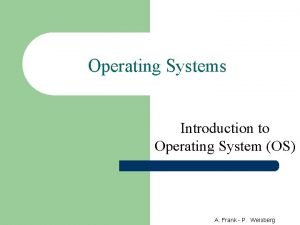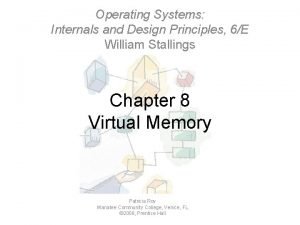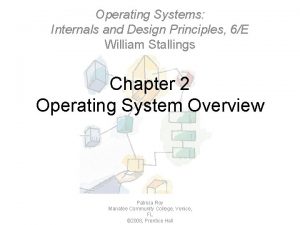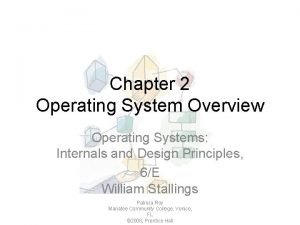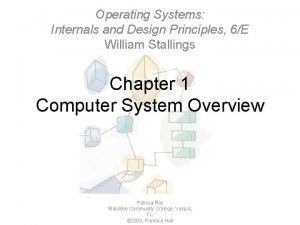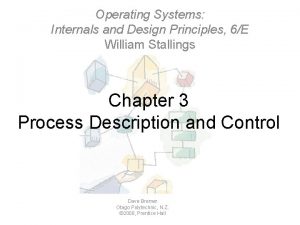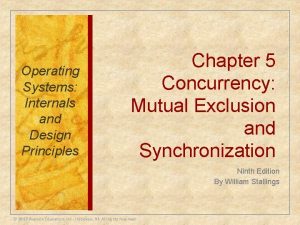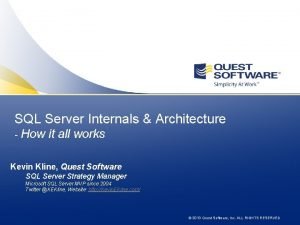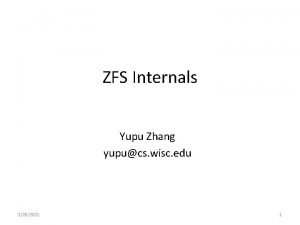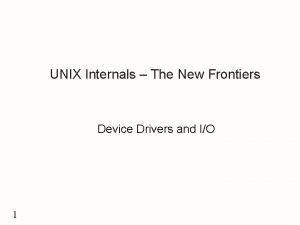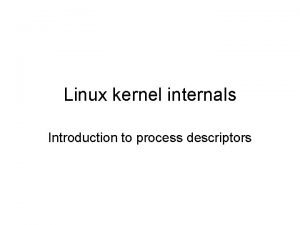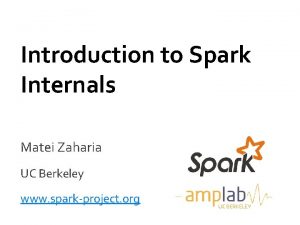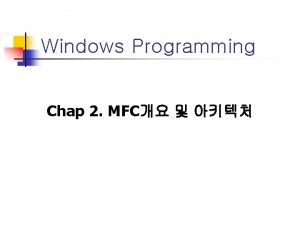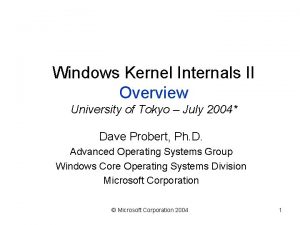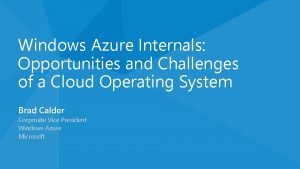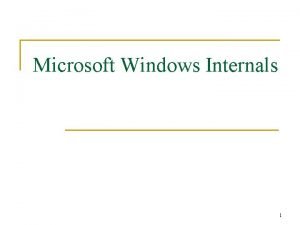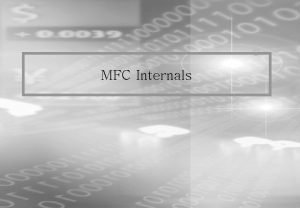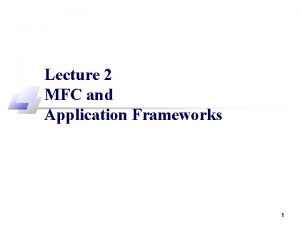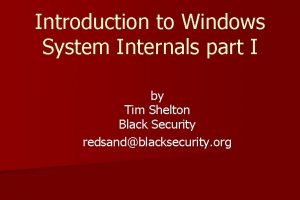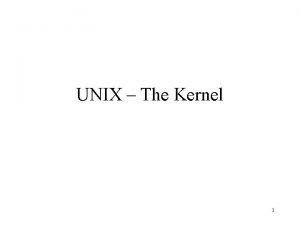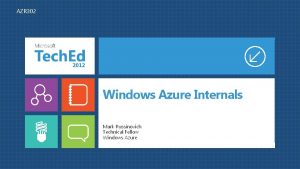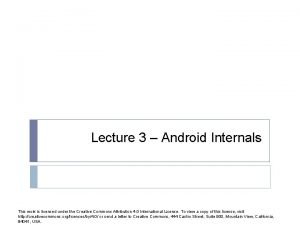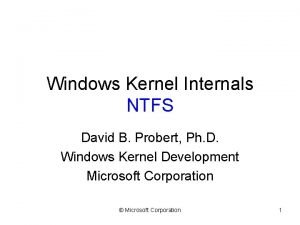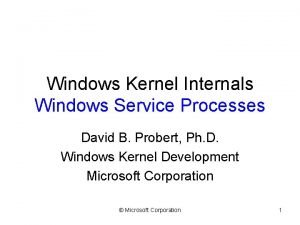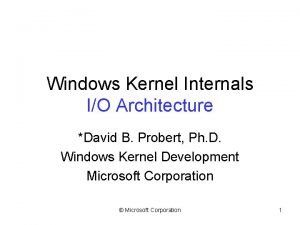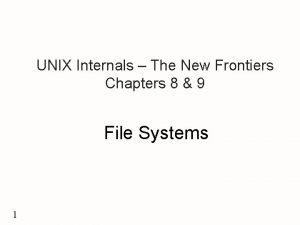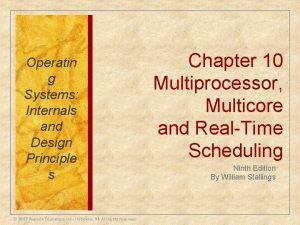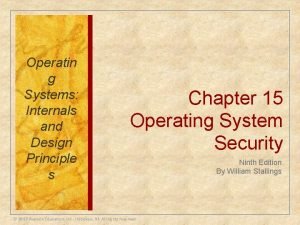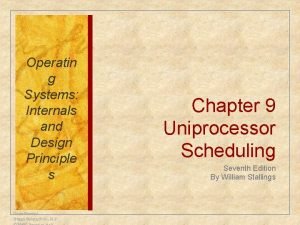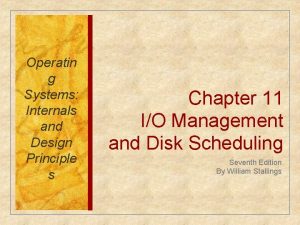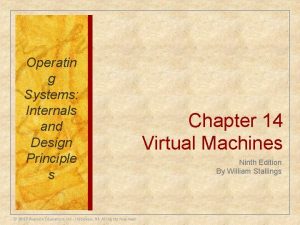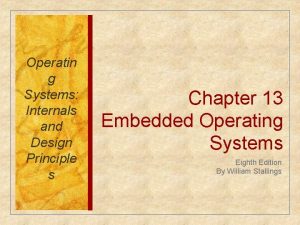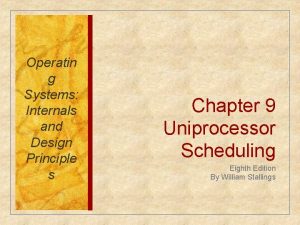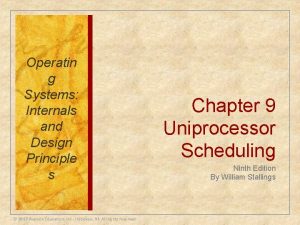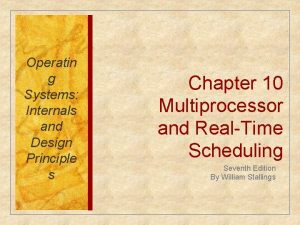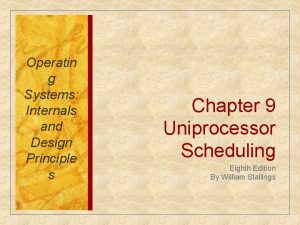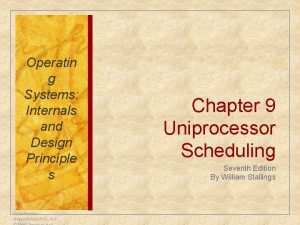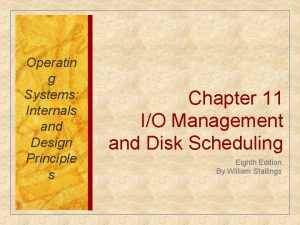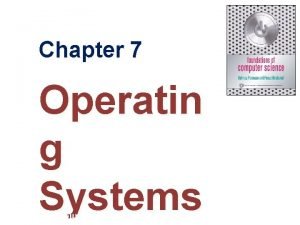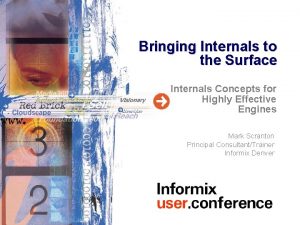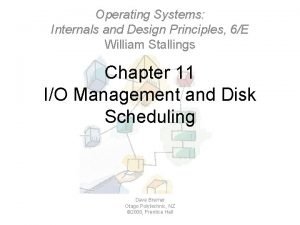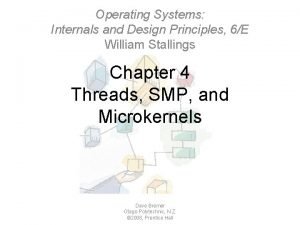Operatin g Systems Internals and Design Principle s










































- Slides: 42

Operatin g Systems: Internals and Design Principle s Chapter 13 Embedded Operating Systems © 2017 Pearson Education, Inc. , Hoboken, NJ. All rights reserved. Ninth Edition By William Stallings

Embedded System n The term embedded system refers to the use of electronics and software within a product that has a specific function or set of functions, as opposed to a general-purpose computer n An embedded system can also be defined as any device that includes a computer chip, but that is not a general-purpose workstation, or desktop or laptop computer n Examples of types of devices with embedded systems include cell phones, digital cameras, video cameras, calculators, home security systems, washing machines, various automotive systems, tennis rackets, toothbrushes, and numerous types of sensors and actuators in automated systems © 2017 Pearson Education, Inc. , Hoboken, NJ. All rights reserved.

Embedded System Constraints, such as required speeds of motion, required precision of measurement, and required time durations, dictate the timing of software operations Often, embedded systems are tightly coupled to their environment This can give rise to real-time constraints imposed by the need to interact with the environment © 2017 Pearson Education, Inc. , Hoboken, NJ. All rights reserved. If multiple activities must be managed simultaneously, this imposes more complex real-time constraints

© 2017 Pearson Education, Inc. , Hoboken, NJ. All rights reserved.

Application Processors vs Dedicated Processors Application Processor Dedicated Processor n Defined by the processor’s ability to execute complex operating systems, such as Linux, Android, and Chrome n Dedicated to one or a small number of specific tasks required by the host device n Is general purpose in nature n n A good example of the use of an embedded application processor is the smartphone Because such an embedded system is dedicated to a specific task or tasks, the processor and associated components can be engineered to reduce size and cost n The embedded system is designed to support numerous apps and perform a wide variety of functions © 2017 Pearson Education, Inc. , Hoboken, NJ. All rights reserved.

Microprocessors n A microprocessor is a processor whose elements have been miniaturized into one or a few integrated circuits n Early microprocessor chips included registers, an arithmetic logic unit (ALU), and some sort of control unit or instruction processing logic n Contemporary microprocessor chips include multiple processors, called cores, and a substantial amount of cache memory n However, a microprocessor chip includes only some of the elements that make up a computer system © 2017 Pearson Education, Inc. , Hoboken, NJ. All rights reserved.

© 2017 Pearson Education, Inc. , Hoboken, NJ. All rights reserved.

Microprocessors n Printed circuit board (PCB) n A rigid, flat board that holds and interconnects chips and other electronic components n Is made up of layers, typically two to ten, that interconnect components via copper pathways that are etched into the board n Motherboard n The main PCB in a computer n Also called a system board n Expansion board n Smaller PCB that plugs into the slots in the main board n Chip n n Most prominent element on the motherboard A single piece of semiconducting material, typically silicon, upon which electronic circuits and logic gates are fabricated The resulting product is referred to as an integrated circuit Multicore processor n The motherboard contains a slot or socket for the processor chip, which typically contains multiple individual cores, in what is known as a multicore processor © 2017 Pearson Education, Inc. , Hoboken, NJ. All rights reserved.

© 2017 Pearson Education, Inc. , Hoboken, NJ. All rights reserved.

Deeply Embedded System n A deeply embedded system has a processor whose behavior is difficult to observe both by the programmer and the user n A deeply embedded system: n Uses a microcontroller rather than a microprocessor n Is not programmable once the program logic for the device has been burned into ROM (read only memory) n Has no interaction with a user n Deeply embedded systems are dedicated, single-purpose devices that detect something in the environment, perform a basic level of processing, then do something with the results n They often have wireless capability and appear in networked configurations, such as networks of sensors deployed over a large area n The Internet of Things depends heavily on deeply embedded systems n Typically, deeply embedded systems have extreme resource constraints in terms of memory, processor size, time, and power consumption © 2017 Pearson Education, Inc. , Hoboken, NJ. All rights reserved.

Characteristics of Embedded OS n Real-time operation n Reactive operation n Configurability n I/O device flexibility n Streamlined protection mechanisms n Direct use of interrupts © 2017 Pearson Education, Inc. , Hoboken, NJ. All rights reserved.

© 2017 Pearson Education, Inc. , Hoboken, NJ. All rights reserved.

Host and Target Environments n Kernel n The full kernel includes a number of separate modules including: n Memory management n Process/thread management n Inter process communication, timers n Device drivers for I/O, network, sound, storage, graphics, etc n File systems n Networking n Power management © 2017 Pearson Education, Inc. , Hoboken, NJ. All rights reserved. n n Boat loader n A small program that calls the OS into memory (RAM) after the power is turned on n It is responsible for the initial boot process of the system and for loading the kernel into main memory Root file system n Contains all the files needed for the system to work properly n The root file system of an embedded OS is similar to that found on a workstation or server, except that it contains only the minimal set of application, libraries, and related files needed to run the system

© 2017 Pearson Education, Inc. , Hoboken, NJ. All rights reserved.

Developing an Embedded OS Two general approaches: • Take an existing OS and adapt it for the embedded application • Design and implement an OS intended solely for embedded use © 2017 Pearson Education, Inc. , Hoboken, NJ. All rights reserved.

Adapting an Existing OS n An existing commercial OS can be used for an embedded system by adding: n Real time capability n Streamlining operation n Adding necessary functionality Advantage: • Familiar interface Disadvantage: • Not optimized for real-time and embedded applications © 2017 Pearson Education, Inc. , Hoboken, NJ. All rights reserved.

Purpose-Built Embedded OS n Typical characteristics include: n Fast and lightweight process or thread switch n Scheduling policy is real time and dispatcher module is part of scheduler n Small size n Responds to external interrupts quickly n Minimizes intervals during which interrupts are disabled n Provides fixed or variable-sized partitions for memory management n Provides special sequential files that can accumulate data at a fast rate © 2017 Pearson Education, Inc. , Hoboken, NJ. All rights reserved.

Timing Constraints © 2017 Pearson Education, Inc. , Hoboken, NJ. All rights reserved. To deal with timing constraints, the kernel: • Provides bounded execution time for primitives • Maintains a real-time clock • Provides for special alarms and timeouts • Supports real-time queuing disciplines • Provides primitives to delay processing by a fixed amount of time and to suspend/resume execution

Embedded Linux n A version of Linux running in an embedded system n Embedded devices typically require support for a specific set of devices, periphrals, and protocols, depending on the hardware that is present in a given device and the intended purpose of that device n An embedded Linux distribution is a version of Linux to be customized for the size and hardware constraints of embedded devices n Includes software packages that support a variety of services and applications on those devices n An embedded Linux kernel will be far smaller than an ordinary Linux kernel © 2017 Pearson Education, Inc. , Hoboken, NJ. All rights reserved.

© 2017 Pearson Education, Inc. , Hoboken, NJ. All rights reserved.

Type Size Time constraints Networkability Degree of user interaction Industrial process control Medium Stringent Yes Low Computer-aided training Aerospace system Large Stringent No High Bluetooth device for accessing local information Small Mild Yes Very low System control and data acquisition protocol Industrial process control converter Medium Stringent No Very low Personal digital assistant Consumer electronics Medium Mild Yes Very high Large Stringent Yes High Description Accelerator control devices Motor control device involved with space vehicle control Networking Aerospace Table 13. 1 Characteristics of Example Embedded Linux Systems (Table is on page 583 in the textbook) © 2017 Pearson Education, Inc. , Hoboken, NJ. All rights reserved.

Embedded Linux File Systems n n File system must be as small as possible Commonly used examples: n cramfs n n n squashfs n n A log-based file system that is designed for use on NOR and NAND flash devices with special attention to flash-oriented issues such as wear-leveling ubifs n n A compressed, read-only file system that was designed for use on low memory or limited storage size environments jffs 2 n n A simple read-only file system that is designed to minimize size by maximizing the efficient use of underlying storage Files are compressed in units that match the Linux page size Provides better performance on larger flash devices and also supports write caching to provide additional performance inprovements yaffs 2 n Provides a fast and robust file system for large flash devices © 2017 Pearson Education, Inc. , Hoboken, NJ. All rights reserved.

Advantages of Embedded Linux n Advantages of using Linux as the basis for an embedded OS include the following: n Vendor independence n n Varied hardware support n n Linux support for a wide range of processor architectures and peripheral devices makes it suitable for virtually any embedded system Low cost n n The platform provider is not dependent on a particular vendor to provide needed features and meet deadlines for deployment The use of Linux minimizes cost for development and training Open source n The use of Linux provides all of the advantages of open source software © 2017 Pearson Education, Inc. , Hoboken, NJ. All rights reserved.

��Clinux n ��Clinux (microcontroller Linux) is a popular open-source Linux kerne variation targeted at microcontrollers and other very small embedded systems n The design philosophy for ��Clinux is to slim down the operating environment by removing utility programs, tools, and other system services that are not needed in an embedded environment © 2017 Pearson Education, Inc. , Hoboken, NJ. All rights reserved.

Differences Between ��Clinux and Linux n Linux is a multiuser OS based on Unix. ��Clinux is a version of Linux intended for embedded systems typically with no interactive user n Unlike Linux, ��Clinux does not support memory management n The Linux kernel maintains a separate virtual address space for each process. ��Clinux has a single shared address space for all processes n �� Clinux modifies device drivers to use the local system bus rather than ISA or PCI © 2017 Pearson Education, Inc. , Hoboken, NJ. All rights reserved. n In Linux, address space is recovered on context switching; this is not done in ��Clinux n Unlike Linux, ��Clinux does not provide the fork system call; the only option is to use vfork n The most significant difference between full Linux and ��Clinux is in the area of memory management

glibc name glibc size µçlibc name µclibc size libc-2. 3. 2. so 1. 2 M libu. Clibc-0. 9. 2. 7. so 284 K ld-2. 3. 2. so 92 K libcrypt-0. 9. 2. 7. so 20 K libcrypt-2. 3. 2. so 20 K libdl-0. 9. 2. 7. so 12 K libdl-2. 3. 2. so 12 K libm-0. 9. 2. 7. so 8 K libm-2. 3. 2. so 136 K libnsl-0. 9. 2. 7 so 56 K libnsl-2. 3. 2. so 76 K libpthread-0. 9. 2. 7. so 4 K libpthread-2. 3. 2. so 84 K libresolv-0. 9. 2. 7. so 84 K libresolv-2. 3. 2. so 68 K libutil-0. 9. 2. 7. so 4 K libutil-2. 3. 2. so 8 K libcrypt-0. 9. 2. 7. so 8 K Table 13. 2 Size of Some Functions in GNU C Library and µClibc (Table is on page 586 in the textbook) © 2017 Pearson Education, Inc. , Hoboken, NJ. All rights reserved.

© 2017 Pearson Education, Inc. , Hoboken, NJ. All rights reserved.

Android n n Focus of Android lies in the vertical integration of the Linux kernel and the Android user-space components Many embedded Linux developers do not consider Android to be an instance of embedded Linux n From the point of view of these developers, a classic embedded device has a fixed function, frozen at the factory © 2017 Pearson Education, Inc. , Hoboken, NJ. All rights reserved. Android An embedded OS based on a Linux kernel More of a platform OS that can support a variety of applications that vary from one platform to the next A vertically integrated system, including some Android specific modifications to the Linux kernel

Tiny. OS n Streamlines to a very minimal OS for embedded systems n Core OS requires 400 bytes of code and data memory combined n Not a real-time OS n There is no kernel n There are no processes n OS doesn’t have a memory allocation system n Interrupt and exception handling is dependent on the peripheral n It is completely nonblocking, so there are few explicit synchronization primitives n Has become a popular approach to implementing wireless sensor network software © 2017 Pearson Education, Inc. , Hoboken, NJ. All rights reserved.

© 2017 Pearson Education, Inc. , Hoboken, NJ. All rights reserved.

Tiny. OS Goals n With the tiny distributed sensor application in mind, the following goals were set for Tiny. OS: n Allow high concurrency n Operate with limited resources n Adapt to hardware evolution n Support a wide range of applications n Support a diverse set of platforms n Be robust © 2017 Pearson Education, Inc. , Hoboken, NJ. All rights reserved.

Tiny. OS Components n Embedded software systems built with Tiny. OS consist of a set of modules (called components), each of which performs a simple task and which interface with each other and with hardware in limited and well-defined ways n The only other software module is the scheduler n Because there is no kernel there is no actual OS n The application area of interest is the wireless sensor network (WSN) © 2017 Pearson Education, Inc. , Hoboken, NJ. All rights reserved. Examples of standardized components include: • Single-hop networking • Ad-hoc routing • Power management • Timers • Nonvolatile storage control

© 2017 Pearson Education, Inc. , Hoboken, NJ. All rights reserved.

Components -- Tasks n A software component implements one or more tasks n Each task in a component is similar to a thread in an ordinary OS n Within a component tasks are atomic n Once a task has started it runs to completion A task cannot: • Be preempted by another task in the same component and there is no time slicing • Block or spin wait © 2017 Pearson Education, Inc. , Hoboken, NJ. All rights reserved. A task can: • Perform computations • Call lower-level components (commands) • Signal higher-level events • Schedule other tasks

Components -Commands n A command is a nonblocking request n A task that issues a command does not block or spin wait for a reply from the lower-level component n Is typically a request for the lower-level component to perform some service n The effect on the component that receives the command is specific to the command given and the task required to satisfy the command n A command cannot preempt the currently running task n A command does not cause a preemption in the called component and does not cause blocking in the calling component © 2017 Pearson Education, Inc. , Hoboken, NJ. All rights reserved.

Components -- Events n Events in Tiny. OS may be tied either directly or indirectly to hardware events n Lowest-level software components interface directly to hardware interrupts n May be external interrupts, timer events, or counter events n An event handler in a lowest-level component may handle the interrupt itself or may propagate event messages up through the component hierarchy n A command can post a task that will signal an event in the future n In this case there is no tie of any kind to a hardware event © 2017 Pearson Education, Inc. , Hoboken, NJ. All rights reserved.

© 2017 Pearson Education, Inc. , Hoboken, NJ. All rights reserved.

Tiny. OS Scheduler n Operates across all components n Only one task executes at a time n The scheduler is a separate component n It is the one portion of Tiny. OS that must be present in any system n Default scheduler is a simple FIFO queue n Scheduler is power aware n Puts processor to sleep when there is no task in the queue © 2017 Pearson Education, Inc. , Hoboken, NJ. All rights reserved.

© 2017 Pearson Education, Inc. , Hoboken, NJ. All rights reserved.

Tiny. OS Resource Interface n Tiny. OS provides a simple but powerful set of conventions for dealing with resources Dedicated • A resource that a subsystem needs exclusive access to at all times • No sharing policy is needed • Examples include interrupts and counters Virtualized • Every client of a virtualized resource interacts with it as if it were a dedicated resource • An example is a clock or timer Shared • Abstraction that provides access to a dedicated resource through an arbiter component • Arbiter determines which client has access to the resource at which time © 2017 Pearson Education, Inc. , Hoboken, NJ. All rights reserved.

© 2017 Pearson Education, Inc. , Hoboken, NJ. All rights reserved.

Summary n Embedded systems n Embedded system concepts n Application versus dedicated processors n Microcontrollers n Deeply embedded systems n Characteristics of embedded operating systems n Host and target environments n Development approaches n Adapting an existing commercial operating system n Purpose-built embedded operating system © 2017 Pearson Education, Inc. , Hoboken, NJ. All rights reserved. n Embedded Linux n Characteristics of an embedded Linux system n Embedded Linux file systems n Advantages of embedded Linux n �� Clinux n Android n Tiny. OS n Wireless sensor networks n Tiny. OS goals n Tiny. OS components n Tiny. OS scheduler n Tiny. OS resource interface
 Operating systems: internals and design principles
Operating systems: internals and design principles Operating systems: internals and design principles
Operating systems: internals and design principles Operating systems: internals and design principles
Operating systems: internals and design principles Operating systems: internals and design principles
Operating systems: internals and design principles Operating systems: internals and design principles
Operating systems: internals and design principles Operating systems internals and design principles
Operating systems internals and design principles Operating system internals and design principles
Operating system internals and design principles Operating system internals and design principles
Operating system internals and design principles Sql server internals and architecture
Sql server internals and architecture Zfs dnode
Zfs dnode Unix device drivers
Unix device drivers Linux kernel internals
Linux kernel internals Jvm internals
Jvm internals Shivaram venkataraman
Shivaram venkataraman Mfc internals
Mfc internals Windows kernel internals
Windows kernel internals Azure internals
Azure internals Windows internals tutorial
Windows internals tutorial Mapstruct cannot find implementation for
Mapstruct cannot find implementation for Mfc 프로그래밍
Mfc 프로그래밍 Windows system internals
Windows system internals Windows kernel internals
Windows kernel internals Namei algorithm
Namei algorithm Host instance
Host instance Android internals
Android internals $index_allocation
$index_allocation Windows kernel internals
Windows kernel internals Windows kernel internals
Windows kernel internals Notifychangedirectory
Notifychangedirectory Vnode unix
Vnode unix Decision support systems and intelligent systems
Decision support systems and intelligent systems System analysis and design kendall
System analysis and design kendall Engineering elegant systems: theory of systems engineering
Engineering elegant systems: theory of systems engineering Embedded systems vs cyber physical systems
Embedded systems vs cyber physical systems Engineering elegant systems: theory of systems engineering
Engineering elegant systems: theory of systems engineering Systems analysis & design in an age of options
Systems analysis & design in an age of options Systems analysis and design in a changing world
Systems analysis and design in a changing world Systems analysis and design in a changing world
Systems analysis and design in a changing world Systems analysis and design in a changing world
Systems analysis and design in a changing world Alan dennis system analysis design
Alan dennis system analysis design Introduction of system analysis and design
Introduction of system analysis and design For designing
For designing Structured system analysis and design
Structured system analysis and design

